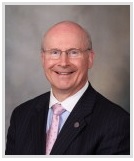Using Neilmed’s platform for accomplishing buffered saline nasal lavage in allergic rhinitis and chronic rhinosinusitis with or without nasal polyposis
 |
Daniel E. Maddox, M.D. Diplomate, ABIM, ABAI, with special qualification in Diagnostic Laboratory Immunology Fellow, American Academy Allergy Asthma & Immunology Consultant, Allergic Diseases & Internal Medicine, Mayo Clinic Specialist in the field of Allergy / Immunology, Dr. Maddox is prepared to provide specialized treatment for allergic reactions and immunological diseases. Dr. Maddox treats and manages disorders such as asthma, hives, and all types of allergies (food, environmental, etc.), rhinitis and sinusitis, as well as other disorders and diseases that affect the body’s immune system. |
I have been a strong proponent for patients accomplishing buffered saline nasal lavage as part of the management of both allergic rhinitis and chronic rhinosinusitis with or without nasal polyposis for quite some time, as data have accumulated in favor of this element in management of these conditions. In allergic rhinitis, studies of mucociliary clearance times for particulates deposited anteriorly suggest that normal clearance times of 15 minutes may be prolonged by up to 6 hours or more, which means that pollen grains embedded in the mucus blanket as the patient is coming home from work in the evening may persist into the sleeping hours, when the inflammatory consequences are substantially magnified. Even with an evening lavage to clear these materials, most allergic rhinitis patients are most congested on first arising mornings, and attempts to estimate what fraction of total nasal inflammation may be attributable to the barotrauma caused by vigorous noseblowing in a congested state suggest surprisingly high fractions; this may be a significant incentive to clear the nose mornings with a gentle buffered saline lavage instead of vigorous noseblowing, so as to sidestep the barotrauma-induced additional inflammation. I have heard a remarkable range of practices reported by patients who have embraced some form of lavage in terms of what they use and how they compound their lavage fluid. I have emphasized to patients that research studies clearly show that the mediator-containing cells in the nasal mucosa are quite sensitive to changes in the osmolar milieu, so that if their lavage fluid is not carefully compounded so as to be isosmolar, and of appropriate pH, they will in effect be activating the very cells that create the chemistry of their allergic reactions. In my experience, the Neilmed system is the only widely available product which enables patients to accurately compound isotonic, buffered physiologic saline, affordably and reproducibly. I often show the brief instructional video on the Neilmed website to patients when I am discussing this process with them. I wish it could be changed in two ways: 1) in addition to washing the hands before starting the process, I would like patients to further attempt to decontaminate the fingers that will touch the cap/tubing assembly with an alcohol-based hand sanitizer, as self-inoculation with respiratory virus in the process of lavage is self-defeating. 2) studies suggest that bacterial biofilms will be established in the bottle, and I would like patients to conclude their lavage by holding the bottle with a spare set of salad tongs, so that it can be filled 4 or 5 times with steaming hot water that is too hot to touch, and then I ask them to store the bottle horizontally after knocking all the water out of it, so that the interior dries in 3 or 4 minutes, instead of inverted, as the video shows, which would entrap the warm moist air and prolong drying of the interior of the bottle to an hour or more. Properly done at least twice daily, buffered saline nasal lavage improves nasal mucosal quality and reduces accumulation of inflammatory debris with sufficient predictability so as to make it a key component of successful management.
(2767)
Helen Velasquez liked this on Facebook.
Peter A Hazlet liked this on Facebook.
La Sean Nesbitt liked this on Facebook.
Roger L. Berry Jr. liked this on Facebook.
Alice M. Tobin liked this on Facebook.
Debbie Brick liked this on Facebook.
Becky Price Goff liked this on Facebook.
Penny Rusnak liked this on Facebook.
Wendy Crossno liked this on Facebook.
Jeanette McKee liked this on Facebook.
Anita Conner liked this on Facebook.
Carl Farris liked this on Facebook.
Denise Crear liked this on Facebook.
Cameron Welch liked this on Facebook.
Stephen Mahieu liked this on Facebook.